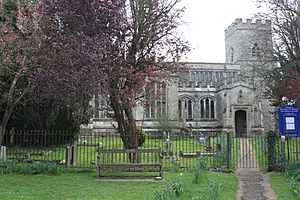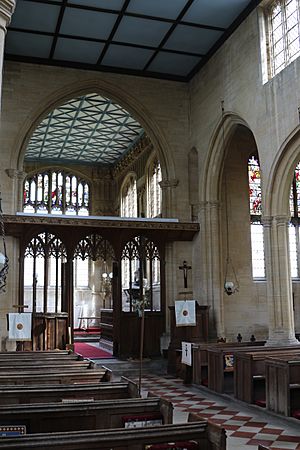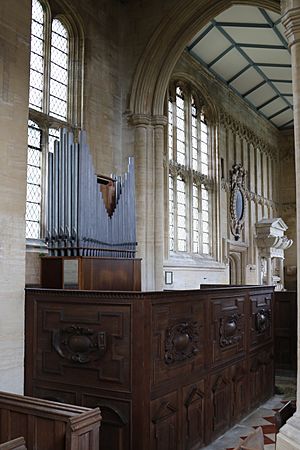All Saints' Church, Hillesden facts for kids
Quick facts for kids All Saints’ Church, Hillesden |
|
|---|---|

All Saints’ Church, Hillesden
|
|
| Location | Hillesden |
| Country | England |
| Denomination | Church of England |
| History | |
| Dedication | All Saints |
| Architecture | |
| Heritage designation | Grade I listed |
| Administration | |
| Parish | Hillesden |
| Deanery | Buckingham |
| Archdeaconry | Buckingham |
| Diocese | Diocese of Oxford |
All Saints’ Church in Hillesden, Buckinghamshire, is a very old and important building. It is a Grade I listed parish church, which means it is considered a building of special historical interest. It belongs to the Church of England.
Contents
History of All Saints’ Church
The tower of All Saints’ Church was built in the 1400s. The rest of the church was rebuilt starting in 1493 by monks from Notley Abbey. It has a special cross shape when viewed from above, with side sections and a porch at the north. There is also a small chapel on the north side of the main altar area. An unusual octagonal staircase on the outside leads to a room for priests and a private chapel above it.
The door of the south porch used to be part of Hillesden House. You can still see bullet holes in it from the English Civil War. This shows that the village was attacked by soldiers during that time.
Restoration Work on the Church
The church was repaired and updated between 1874 and 1875 by a famous architect named George Gilbert Scott. He was born in a nearby village called Gawcott. This church was one of the reasons he became interested in designing buildings in the Gothic style. He worked on the church for free!
The church officially reopened on June 16, 1875. During this restoration, the roofs were replaced. A new ceiling was added with beautiful oak panels. The old wooden seats were fixed, and new ones were made to match them. The pulpit, where sermons are given, was also updated. A screen was repaired and put in place to separate a special prayer area from the side sections. Even a tomb inside the church was fixed.
The beautiful stained glass windows were carefully put back together by artists named Burlison and Grylls. A brand new window was also added, showing stories from the Bible. The church was also restored again in the 1960s to keep it in good condition.
Church Leaders Over Time
The church was looked after by monks from Notley Abbey for a long time, starting in 1162. This means that the names of all the early priests or curates are not fully known. The first recorded curate was John Orchard in 1526.
After the Dissolution of the Monasteries (when many monasteries were closed), the church was given to Christ Church, Oxford in 1542. Later, in 1546, it was given to a new group created by King Henry VIII.
The house where the church's minister lived, called the Vicarage, was rebuilt in 1869. After this, the ministers of All Saints’ Church were called Vicars.
List of Vicars
- 1860 Robert Holt
- 1904 Cecil H Hopper
- 1910 James L Bowley MA
- 1939 Eric Edwards
- 1943 John G Campbell
- 1957 Patrick Moore
- 1960 Interregnum
- 1962 Aubrey F.T. Newell BA
- 1987 John Hudson CSS FRSA
- 2002 Jenny J. Shields Cert Ed. Assoc. Priest
- 2004 Tom Gibbons BA
- 2008 Rosamunde M. Roberts SRN, SCM, DipTh & Min.
Churches in the Same Parish
All Saints’ Church is part of a group of churches that work together. This group is called a joint parish. The other churches in this parish are:
- St Cecilia's Church, Adstock
- Holy Trinity Church, Gawcott
- St Mary the Virgin's Church, Padbury
Stained Glass Windows
The church has several beautiful stained glass windows.
Memorials and Tombs
Inside the church, there are memorials to several important people from the past. These include:
- Catharine Denton (died 1733)
- Dr William Denton (died 1691)
- George Woodward (died 1735)
- Alexander Denton (died 1576)
- Elizabeth Denton (died 1667)
- Thomas Isham (died 1676)
- Godfrey Boate (died 1722)
- Mary Rowe, Viscountess of Hillsborough (died 1742)
The Church Organ
The pipe organ in the church was built in 1970 by George Osmund. You can find more details about this organ on the National Pipe Organ Register.







